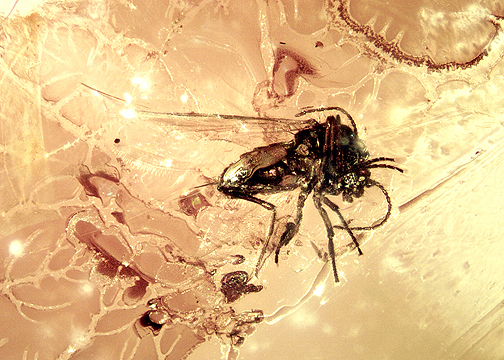Abstract
Lebanon has an extraordinarily high proportion of Mesozoic amber outcrops, some (19 outcrops) from the Kimmeridgian, Upper Jurassic (Azar et al., 2010b; Nohra et al., 2013; Maksoud & Azar, 2020); and others (more than 450 outcrops) from the lower Barremian (Granier et al., 2016; Maksoud et al., 2017; Maksoud et al., 2022), Lower Cretaceous (Maksoud & Azar, 2020). The latter number is still endlessly growing (for a very small country with a total surface of 10,452 km2). To date 28 outcrops yielding biological inclusions are known (Maksoud et al., 2019, 2020, 2021a, b, c; Maksoud & Azar, 2022).
References
- Azar, D. (1997) A new method for extracting vegetal and insect fossils from the Lebanese amber. Palaeontology, 40, 1027–1029.
- Azar, D. (2007) Preservation and accumulation of biological inclusions in Lebanese amber and their significance. Comptes Rendus Palevol, 6, 151–156. https://doi.org/10.1016/j.crpv.2006.10.004
- Azar, D. (2012) Lebanese amber: a “Guinness Book of Records”. Annales Universitatis Paedagogicae Cracoviensis, 111, 44–60.
- Azar, D., Gèze, R. & Acra, F. (2010a) Chapter 14: Lebanese amber. In: Penney, D. (Ed.), Biodiversity of fossils in amber from the major world deposits. Siri Scientific Press, Manchester, pp. 271–298.
- Azar, D., Gèze, R., El-Samrani, A., Maalouly, J. & Nel, A. (2010b) Jurassic amber in Lebanon. Acta Geologica Sinica—English Edition, 84, 977–983. https://doi.org/10.1111/j.1755-6724.2010.00228.x
- Azar, D. & Nel, A. (1998) Lebanese Lower Cretaceous amber. Meganeura, 2, 18–20.
- Dubertret L. (1950) Carte géologique au 1:50 000—Feuille de Djezzîne. République Libanaise, Ministère des travaux publics, Beyrouth, 1 coloured map + notice 80 pp.
- Dubertret L. (1951) Carte géologique au 1:50 000—Feuille de Beyrouth. République Libanaise, Ministère des travaux publics, Beyrouth, 1 coloured map + notice 66 pp.
- Azar, D. Perrichot, V. Néraudeau, D. & Nel, A. (2003) New psychodid flies from the Cretaceous ambers of Lebanon and France, with a discussion about Eophlebotomus connectens Cockerell, 1920 (Diptera, Psychodidae). Annals of the American Society of America, 96 (2), 117–127. https://doi.org/10.1603/0013-8746(2003)096[0117:NPFTCA]2.0.CO;2
- Granier, B., Azar, D., Maksoud, S., Gèze, R. & Habchi, R. (2015) New fossiliferous sites with Barremian Charophyta in the «Grès du Liban» auct. (Lebanon), with a critical perspective regarding the nature of Munieria Deecke, 1883. Carnets de Géologie, 15 (15), 199–229. https://doi.org/10.4267/2042/57947
- Granier, B., Toland, C., Gèze, R., Azar, D. & Maksoud, S. (2016) Some steps toward a new story for the Jurassic–Cretaceous transition in Mount Lebanon. Carnets de Géologie, 16 (8), 247–269. https://doi.org/10.4267/2042/59924
- Maksoud, S. & Azar, D. (2020) Lebanese amber: latest updates. Palaeoentomology, 3 (2), 125–155. https://doi.org/10.11646/palaeoentomology.3.2.2
- Maksoud, S. & Azar, D. (2022) A new early Barremian amber outcrop from Mount Sannine (Central Lebanon). Palaeoentomology, 5 (1), 71–75. https://doi.org/10.11646/palaeoentomology.5.1.8
- Maksoud, S., Azar, D., Granier, B. & Gèze, R. (2017) New data on the age of the Lower Cretaceous amber outcrops of Lebanon. Palaeoworld, 26 (2), 331–338. https://doi.org/10.1016/j.palwor.2016.03.003
- Maksoud, S., Granier, B. & Azar, D. (2022) Palaeoentomological (fossil insects) outcrops in Lebanon. Carnets de Géologie, 22 (12), 567–617. https://doi.org/10.2110/carnets.2022.2212
- Maksoud, S., Maalouf, M., Maalouf, R. & Azar, D. (2021a) Baskinta and Bqaatouta: Two new early Barremian fossiliferous amber outcrops from Central Lebanon. Palaeoentomology, 4 (4), 367–373. https://doi.org/10.11646/palaeoentomology.4.4.12
- Maksoud, S., Taleb, K. & Azar, D. (2019) Four new Lower Barremian amber outcrops from Northern Lebanon. Palaeoentomology, 2 (4), 333–339. https://doi.org/10.11646/palaeoentomology.2.4.6
- Maksoud, S., Taleb, K. & Azar, D. (2021b) New early Barremian fossiliferous amber outcrop from North Lebanon. Palaeoentomology, 4 (1), 23–26. https://doi.org/10.11646/palaeoentomology.4.1.4
- Maksoud, S., Zaidan, O.T. & Azar, D. (2021c) Kfar Selouan: A new early Barremian fossiliferous amber outcrop from Lebanon. Palaeoentomology, 4 (3), 257–265. https://doi.org/10.11646/palaeoentomology.4.3.13
- Maksoud, S., Ziadé, K., Gèze, R. & Azar, D. (2020) New early Barremian amber outcrops from Central Lebanon. Palaeoentomology, 3 (4), 415–422. https://doi.org/10.11646/palaeoentomology.3.4.14
- Nohra, Y., Azar, D., Gèze, R., Maksoud, S., El-Samrani, A. & Perrichot, V. (2013) New Jurassic outcrops from Lebanon. Terrestrial Arthropod Reviews, 6, 27–51. https://doi.org/10.1163/18749836-06021056
- Poinar, G.O. & Milki, R. (2001) Lebanese amber: the oldest insect ecosystem in fossilized resin. Oregon State University Press, Corvallis, Oregon, 96 pp.


